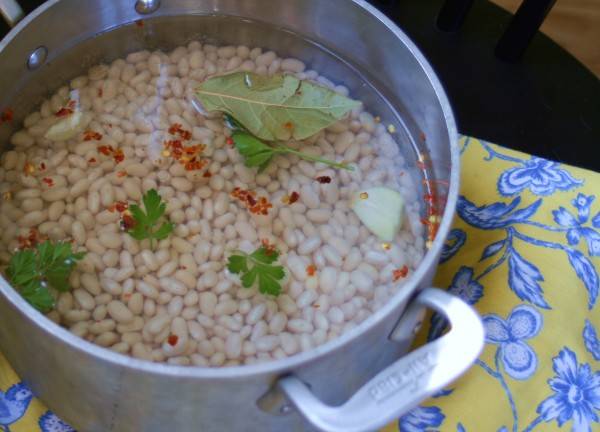There are some things I do in the kitchen that are worthwhile to me, but may not matter much to everyone else. I’m sure you’ve seen a few of these things on this blog (half bread flour and half all purpose, really? Make your own vanilla? C’mon.)
I’m going to suggest something that you may initially scoff at, but I plead you to try it. Instead of opening a can of beans, soak and cook your own. Here are all of the reasons I think this is time well spent:
- Really and truly, they taste better. Canned beans are mushy and often have an off-taste.
- Economics: You can get a pound of dried beans for about $1.50, which yields 5-6 cups of cooked beans, (which often lasts my family about two meals.) A single can of beans costs about the same, and yields a cup and a half. You usually need at least two cans for a single meal. I’ll let you do the math.
- David Tanis says canned beans have no soul.
- You can get really neat dried heirloom varieties of beans here, that you will never find in a can.
- When you cook beans, not only do you get beans, but you get a tasty broth too.
- Most cans are lined with BPA. I know, the jury is still out, but I’m not waiting for them to come back in.
- If you’re lucky enough to have a pressure cooker, you can skip the soaking and have your beans in about 30 minutes.
Here’s the method:
Do a quick sort to make sure there are no pebbly bits in your beans.
Soak your beans in a big bowl with plenty of water. Overnight is spectacular, but if you forget, drop them in first thing in the morning, and you can be cooking by lunchtime. At least four hours is needed. You can do a quick soak, which entails bringing the water to a full boil, and then turning it off and soaking for at least an hour, but I haven’t gotten very good results when I’ve tried this.
Drain your beans. Return them to your large pot, and cover with several inches of water. Bring to a full boil for about 5 minutes. Skim off any foam that accumulates. Turn heat down to a simmer, partially cover, and cook until beans are tender, but not falling apart.
I find that white beans cook the fastest, and chickpeas and black beans take the longest. Kidney and pintos are middle of the road. I wish I could tell you exactly how long your beans will take to reach the perfect texture, but it honestly depends on too many factors, like the freshness of your beans and the hardness of your water, so just pay attention the first time you make them. Count on at least 45 minutes to an hour for white or small beans, and up to two hours for large beans or chickpeas.
Things to try: Adding flavorings to your cooking water. As you can see above, I added a smashed clove of garlic, a few sprigs of parsley, some crushed red pepper, and a bayleaf to my small navy beans. This left me with lightly scented beans, and a pleasant tasting broth. These are my standard add-ins for general bean cooking, but you can get creative – if I were going Mexican, I might throw in garlic, jalepeno, and some cumin seed. For chickpeas destined for something Middle Eastern, maybe garlic and lemon peel.
But whatever you do, don’t add in salt or anything overly acidic (like tomatoes) until after the beans have reached optimum tenderness. Otherwise, they will seize up and never relent, and you will be sad as you sit crunching on your bean soup.
Any leftover beans can be stored in their liquid for up to two days in the fridge. If you know you aren’t going to use them up by then, you can drain and spin them dry in a salad spinner, then freeze. Frozen beans can go right into a warm skillet, and be ready for dinner in a few minutes.
Here are some ways to use your beans:
Veggie burgers
A whole slew of bean recipes from Heidi Swanson at 101 Cookbooks
Channa masala from A Little Yumminess (this is a staple at our house, but I sub in cooked beans for the cans, and add the cooking water instead of plain water)


Comments 15